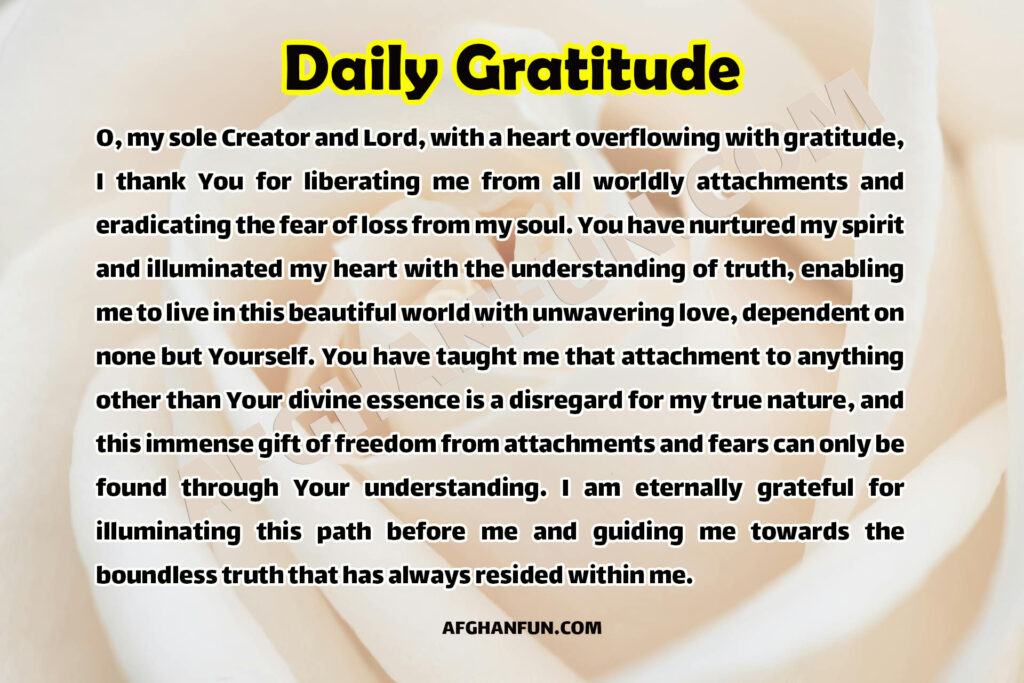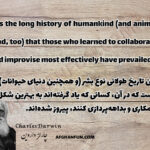
O, my sole Creator and Lord, with a heart overflowing with gratitude, I thank You for liberating me from all worldly attachments and eradicating the fear of loss from my soul. You have nurtured my spirit and illuminated my heart with the understanding of truth, enabling me to live in this beautiful world with unwavering love, dependent on none but Yourself. You have taught me that attachment to anything other than Your divine essence is a disregard for my true nature, and this immense gift of freedom from attachments and fears can only be found through Your understanding. I am eternally grateful for illuminating this path before me and guiding me towards the boundless truth that has always resided within me.
یگانه آفریدگار و پروردگار من، تو را از صمیم قلب سپاس میگویم که مرا از تمامی وابستگیهای دنیوی رهایی بخشیدی و ترس از دست دادن را از دل و جانم زدودی. تو چنان روحم را پرورش دادی و نوری از درک حقیقت بر قلبم افکندی که اکنون میتوانم عاشقانه در این جهان زیبا زندگی کنم، بدون آنکه به چیزی جز خودِ تو وابسته باشم. به من آموختی که دلبستگی به چیزی جز ذات پاکت، به معنای غفلت از حقیقت وجودی خود است و این هدیهی عظیم را که آزادی از دلبستگیها و ترسهاست، تنها از درک تو میتوان یافت. از تو سپاسگزارم که این راه روشن را پیش روی من گشودی و مرا به سوی آن حقیقت بیپایان هدایت کردی که همواره در درون من است.
Эй Худои Ягон, ман туро аз самими дил шукргузорӣ мекунам, ки маро аз ҳамаи пайвастагиҳои дунявӣ озод намудӣ ва тарси аз даст доданро аз дилам дур кардӣ. Ту чунон руҳамро бузург кардӣ ва нуреро аз фаҳмиши ҳақиқат ба дилам афтондӣ, ки акнун ман метавонам дар ин ҷаҳон бо ишқ ва муҳаббат зиндагӣ кунам, бидуни он ки ба чизе ҷуз вуҷудат вобаста бошам. Ба ман омӯхтӣ, ки вобастагӣ аз чизе ҷуз худои покат маънои ғофил будан аз ҳақиқати мавҷудияти худам аст. Ва ин туҳфа ваҳшатангез, ки озодӣ аз вобастагӣ ва тарс аст, танҳо аз шеносоии ту ба даст меояд. Аз ту шукргузорам, ки роҳи равшанро пеши роҳи ман кушодӣ ва маро ба он ҳақиқати беиқтиёр раҳнамоӣ кардӣ, ки ҳамеша дар дохили ман аст.
إلهي الواحد، أشكرك من أعماق قلبي لأنك حرّرتني من جميع التعلقات الدنيوية وأبعدت عني خوف الفقدان. لقد كبرت روحي وأضاءت بنور من فهم الحقيقة، حتى أتمكن من العيش في هذا العالم بحب عميق من دون أن أكون متعلقًا بشيء سوى ذاتك المقدسة. علمتني أن التعلق بأي شيء سوى وجودك هو غفلة عن الحقيقة التي أعيشها، وهذه الهبة العظيمة التي هي الحرية من التعلقات والخوف لا أجدها إلا في إدراكك. أشكرك لأنك فتحت لي هذا الطريق المضيء وهداني إلى تلك الحقيقة اللامتناهية التي هي دائمًا في داخلي.
This gratitude passage is deeply introspective and spiritually profound, reflecting themes of liberation, divine connection, and personal transformation. Here’s a breakdown of its key elements:
1. Address to the Creator and Lord
The speaker begins by acknowledging a direct and intimate relationship with the divine. The phrase “O, my sole Creator and Lord” sets the tone for a deeply personal expression of thankfulness, acknowledging the Creator as the sole source of existence and guidance. The use of “sole” emphasizes the singular importance of the Creator in the speaker’s life.
2. Gratitude for Liberation
The speaker expresses profound gratitude for being “liberated from all worldly attachments” and having “the fear of loss eradicated.” This highlights the central theme of spiritual freedom. The notion of worldly attachments and the fear of loss is a powerful psychological and emotional burden, often associated with impermanence and suffering. The speaker is thanking the Creator for a release from these shackles, which is a key element in many spiritual traditions—freedom from attachment leads to peace and inner tranquility.
3. Nurturing and Illumination
The gratitude extends to the Creator for nurturing the spirit and illuminating the heart. This suggests a process of spiritual growth and enlightenment, where the individual’s heart and mind are opened to the “understanding of truth.” The use of “illuminated” indicates a metaphorical light, suggesting clarity and insight that dispel ignorance or confusion.
4. Unconditional Love and Dependence on the Divine
The speaker mentions being enabled “to live in this beautiful world with unwavering love, dependent on none but Yourself.” This part reflects a sense of unconditional love—not bound to any earthly person or object, but centered entirely on the divine. It implies a state of emotional and spiritual maturity, where the speaker is no longer dependent on external sources for peace or fulfillment. The idea of love here transcends attachment and is rooted in the divinity of the Creator.
5. Teaching the True Nature
The passage then expresses a key teaching: “attachment to anything other than Your divine essence is a disregard for my true nature.” This reflects the idea that attachment to the transient world is a distraction from the eternal truth that resides within. The speaker is acknowledging that their true nature is divine and that any attachment to the material or worldly is a misalignment with their true self. This echoes philosophical and spiritual traditions that emphasize detachment as a path to self-realization.
6. Freedom as a Divine Gift
The speaker identifies freedom from attachments and fears as an “immense gift” granted through the understanding of the Creator. This positions the freedom not as an individual achievement, but as a divine blessing. It reinforces the idea that spiritual freedom is not self-willed but a result of divine guidance and understanding. The use of “immense gift” adds weight to the value and significance of this freedom.
7. Eternal Gratitude for Guidance
Finally, the speaker expresses “eternal gratitude” for being shown the path and guided toward a “boundless truth.” The use of “eternal” suggests that this gratitude is not a transient feeling but a lifelong or timeless recognition. The “path” refers to the spiritual journey, and the “boundless truth” implies an understanding that transcends the limitations of the material world—a truth that is infinite and always present.
Overall Themes:
- Spiritual Liberation: The speaker is expressing gratitude for liberation from worldly attachments and fears, emphasizing spiritual freedom.
- Divine Guidance: The passage underscores the importance of the Creator’s role in providing understanding and enlightenment, leading the speaker toward a higher truth.
- Detachment vs. Attachment: A key spiritual teaching within the gratitude is the difference between healthy detachment from the material world and destructive attachment to transient things.
- Eternal Gratitude: The gratitude is not momentary; it reflects an ongoing, transformative experience of growth and understanding, a continual return to the divine truth.
Style and Tone:
The tone is reverential, reflective, and deeply sincere. The language is rich with metaphor and spiritual imagery—”illuminated my heart,” “nurtured my spirit,” “boundless truth.” These phrases evoke a sense of divine grace and inner awakening. The overall mood is one of peace, liberation, and profound connection with the divine, marking a transition from dependency to spiritual autonomy rooted in divine understanding.











